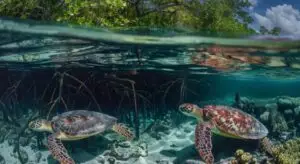Businesses must build scalable and sustainable models that provide long-term economic and environmental returns. For investors, these models must also offer clear financial returns alongside measurable impact. Building such ventures is crucial for attracting capital investment, fostering investor confidence, and driving growth in the blue economy.
In this article, we will explore how to develop sustainable and scalable blue economy ventures, using metrics and milestones to demonstrate long-term viability. We also highlight innovative financial returns that align with capitalistic development.
Step 1: Establishing a Scalable Business Model in Ocean-Based Sectors
Scalability is key to gaining investor confidence. Business models must have the capacity to grow operations, increase revenues, and maintain or even reduce costs per unit. This is especially true in ocean-based sectors like sustainable fisheries, aquaculture, and renewable energy.
Key Metric: Revenue per Unit of Resource Utilized – This metric assesses how much revenue is generated per unit of resource utilized—whether it’s fish, energy, or tourism-related. A scalable venture demonstrates increasing revenue per unit as operations grow, which assures investors of efficient use of resources.
Milestone Example: An aquaculture business might aim to produce 500 metric tons of sustainable seafood by year three while achieving a revenue target of $2,000 per ton. The scalability can be shown by expanding production to 1,000 metric tons in year five while increasing revenue per ton through operational efficiency and reduced costs.
Case Study: Aqua-Spark, a sustainable aquaculture investment fund, demonstrates scalability by investing in companies that maximize revenue per unit of seafood produced while minimizing environmental impact. Their model leverages innovative technologies that enhance production without expanding resource use.
Step 2: Developing Innovative Financial Mechanisms
The blue economy offers unique opportunities for financial returns through mechanisms like blue bonds, sustainability-linked loans, and marine-based ecosystem services. Building scalable business models around these innovative financing options can attract capital while promoting sustainability.
Key Metric: Financial Return on Blue Bonds Issued – This metric measures the financial return to investors for each blue bond issued. Blue bonds are debt instruments that raise capital for ocean-related projects, with returns often tied to the success of environmental and economic milestones.
Milestone Example: A marine conservation project could aim to raise $10 million through a blue bond issuance, projecting a 4% annual return to investors tied to milestones such as protecting 200 hectares of coral reef within two years. Upon success, future blue bond issuances could aim for larger projects with higher returns, demonstrating scalability.
Case Study: The Nature Conservancy’s Blue Bonds for Conservation initiative helped Belize restructure its national debt while investing in marine conservation. This financial innovation allowed the country to scale its conservation efforts while generating returns for investors through debt restructuring tied to environmental outcomes.
Step 3: Building Sustainable Eco-Tourism Models
Eco-tourism is a growing sector of the blue economy, providing both environmental benefits and unique financial returns. Scalable eco-tourism ventures attract investors by offering growth potential tied to sustainable practices, which ensures the long-term preservation of marine environments while driving economic development.
Key Metric: Revenue Growth from Sustainable Tourism – This metric tracks the increase in revenue generated from eco-tourism activities that do not degrade marine ecosystems. A scalable business model in this space would increase revenue while maintaining or enhancing the environmental quality of the destination.
Milestone Example: A coastal eco-tourism business might aim to attract 10,000 visitors in year one, generating $1 million in revenue, while maintaining 90% of the coral reef’s health. By year three, it could aim to double the number of visitors while preserving or improving ecosystem quality, thus showing scalability without sacrificing sustainability.
Case Study: Misool Eco Resort in Indonesia has built a sustainable tourism model centered around marine conservation. By scaling operations and expanding eco-tourism activities, Misool has increased revenue while protecting surrounding marine ecosystems, offering both ecological and financial returns.
Step 4: Monetizing Marine-Based Ecosystem Services
Ecosystem services provided by healthy marine environments—such as carbon sequestration, biodiversity, and coastal protection—can be monetized to generate unique financial returns. Building scalable business models that capitalize on these services attracts investors seeking long-term sustainability and profit.
Key Metric: Ecosystem Service Value per Hectare Restored – This metric measures the financial value of restoring marine ecosystems, such as mangroves, coral reefs, or seagrass beds. A scalable model increases the value of ecosystem services per hectare as more land is restored.
Milestone Example: A coastal restoration company could aim to restore 100 hectares of mangroves within the first two years, generating $100,000 in carbon credits. Over five years, it could expand to 500 hectares and aim to generate $500,000 in carbon credits, proving its ability to scale.
Case Study: Mikoko Pamoja, a blue carbon project in Kenya, sells carbon credits generated through mangrove restoration. By expanding the project and increasing the number of credits sold, Mikoko Pamoja has shown that ecosystem services can be a scalable and profitable business model.
Step 5: Leveraging Blended Finance for Scalability
Blended finance combines public, philanthropic, and private capital to reduce risk for investors and drive scalable growth in blue economy ventures. By using public or charitable funds to cover initial risks, private capital can be attracted to scale-up operations.
Key Metric: Private Capital Leveraged per Public Dollar – This metric tracks how much private capital is mobilized for every dollar of public or philanthropic investment. A higher leverage ratio indicates a scalable model that efficiently uses public funds to attract private investment.
Milestone Example: A marine renewable energy company could secure a $2 million grant from a development bank to leverage $6 million in private investment, achieving a 1:3 leverage ratio. Over five years, the company could aim to double the amount of private capital mobilized, proving its capacity for scalable growth.
Case Study: The Global Environment Facility (GEF) has used blended finance to mobilize private investment in ocean-related projects, leveraging $12 billion in private funding from an initial investment of $3 billion in public funds. This model demonstrates the scalability of ventures that attract public and private capital.
Step 6: Incorporating Ocean-Based Renewable Energy into Scalable Ventures
Ocean-based renewable energy, including offshore wind, tidal, and wave energy, presents a significant opportunity for scalability in the blue economy. Developing scalable business models around these technologies can drive investor confidence and contribute to long-term energy security.
Key Metric: Energy Output per Dollar Invested – This metric measures the energy generated for every dollar invested in ocean-based renewable energy projects. A scalable model would see this output increase as more capital is secured, offering higher returns on investment.
Milestone Example: An offshore wind energy project could set a target of generating 50 megawatts (MW) of energy in year one, with an investment of $100 million. By year three, the company could aim to scale up production to 150 MW with an additional $150 million investment, showing scalability in energy generation and financial returns.
Case Study: Ørsted, a global leader in offshore wind, has scaled its operations significantly by attracting private and public investment. By expanding its offshore wind capacity, Ørsted has demonstrated the scalability and profitability of ocean-based renewable energy.
Building Investor Confidence by Scaling the Blue Economy
The blue economy holds immense potential for long-term, sustainable economic growth. By building scalable business models, ventures in sectors like eco-tourism, marine renewable energy, aquaculture, and ecosystem services can attract investor confidence and capital.
Utilizing innovative financial mechanisms such as blue bonds, blended finance, and monetization of ecosystem services ensures that these ventures are not only financially viable but also environmentally responsible.
As Peter Thomson, UN Special Envoy for the Ocean, has said: “The blue economy is the future. We have to invest in it today to secure tomorrow.” The path forward lies in scaling sustainable ventures that combine financial returns with ocean conservation, ensuring the prosperity of both the planet and the economy.
Sources:
Aqua-Spark. “Investing in Aquaculture for a Sustainable Future.”
Global Environment Facility. “Blended Finance for the Blue Economy.”
Ørsted. “Offshore Wind Energy Leadership.”
Misool Eco Resort. “Marine Conservation through Sustainable Tourism.”




